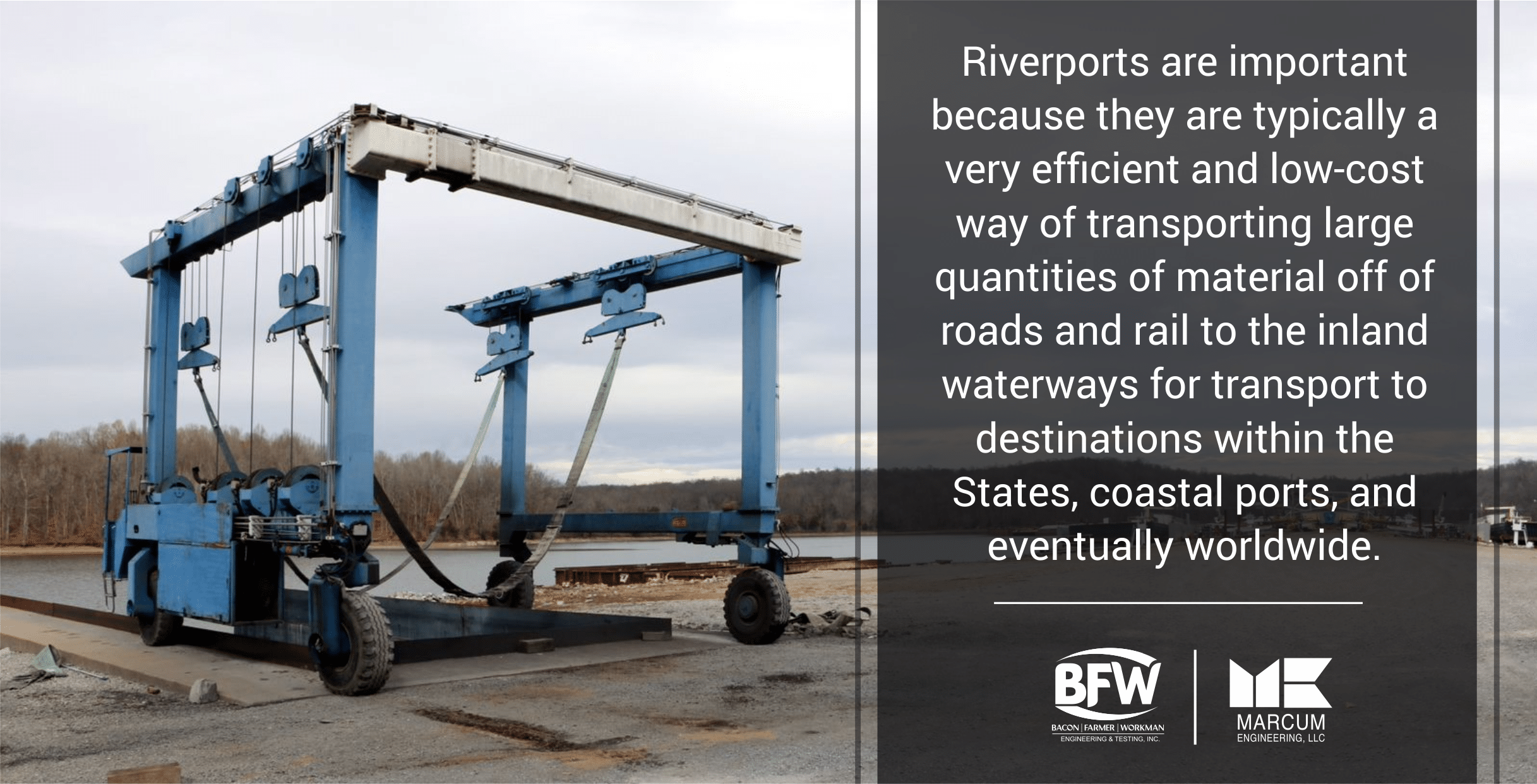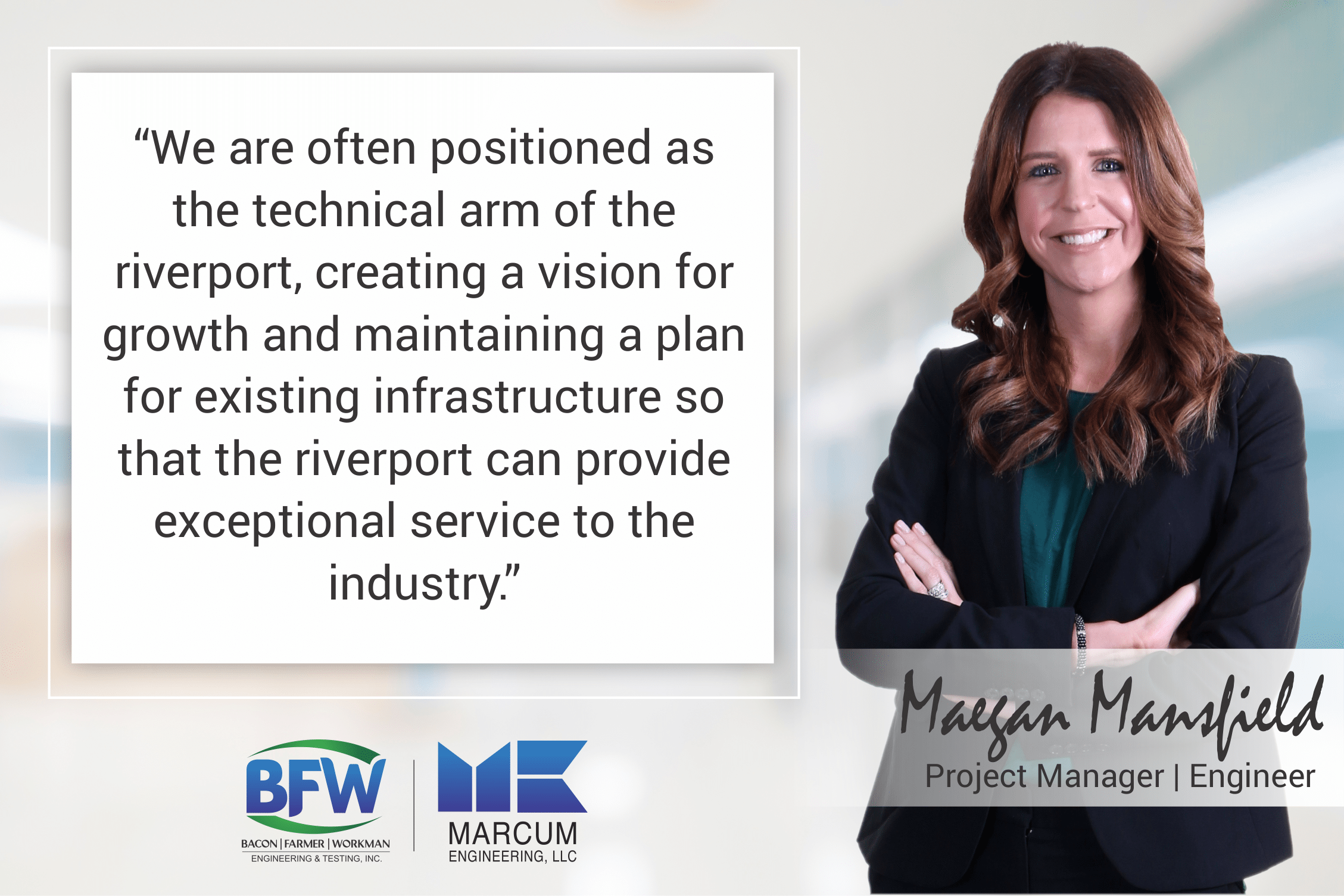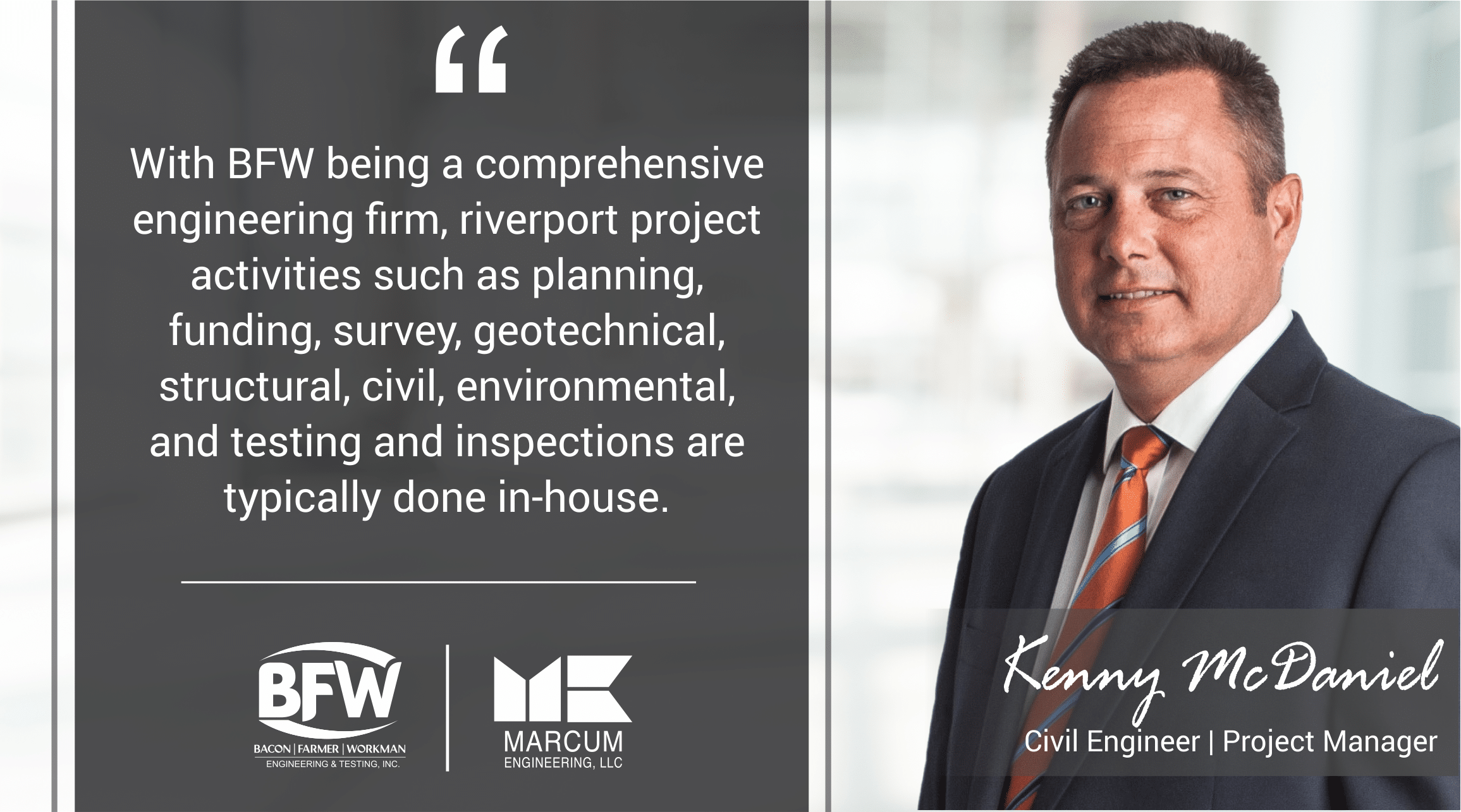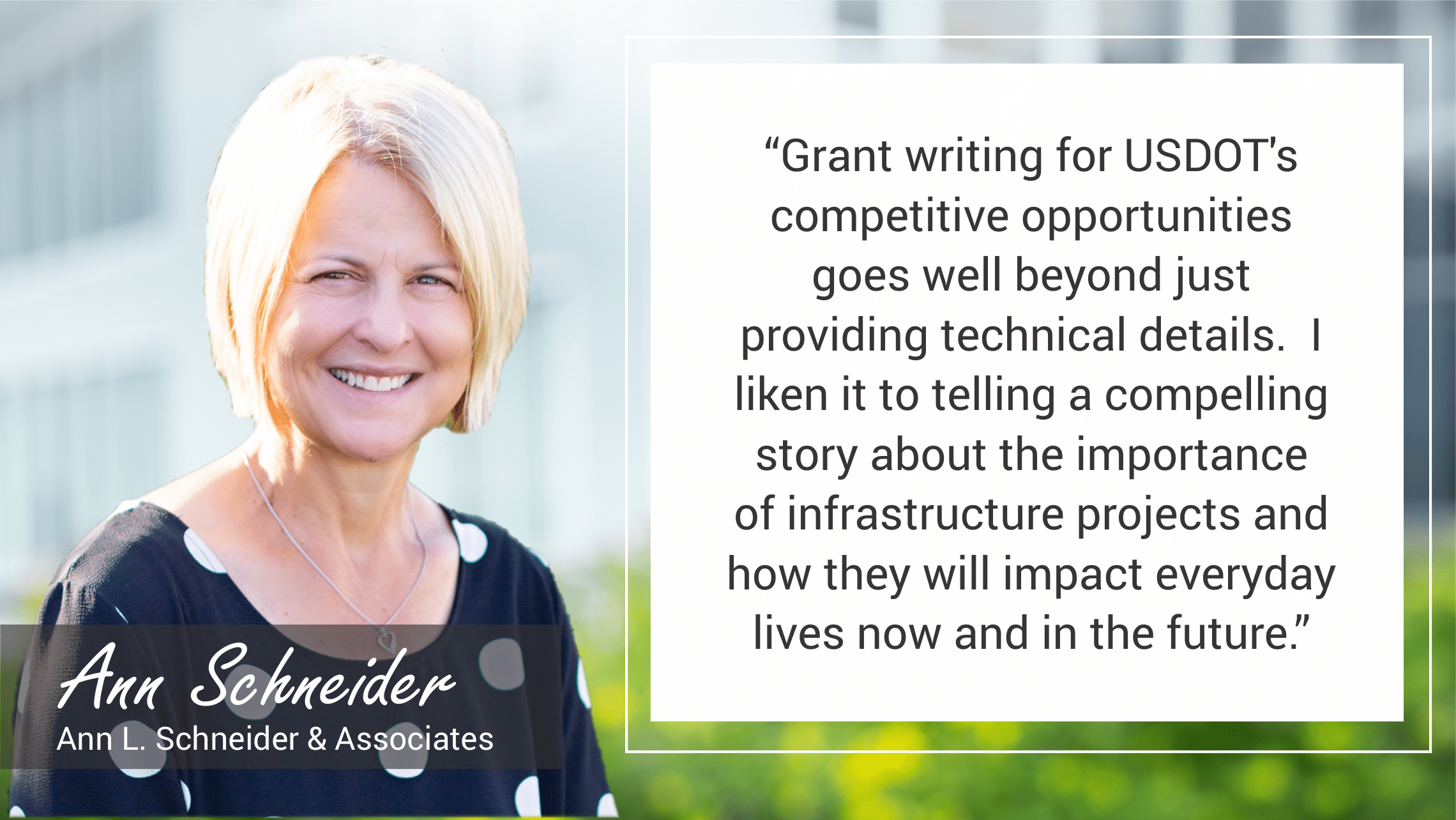Riverports: A Long Tradition of Transportation
If it’s not broken, don’t fix it. That philosophy isn’t always true, but it certainly works when you’re describing the power, convenience, and reliability of a major river. Whether you’re speaking of the ancient indigenous populations of the Kentucky region, to contemporary freight transport companies, neither group has taken that power for granted. Today, our use of those major riverways is no longer isolated to the canoe or even the riverboat. Instead, barges or vessels move our goods from place to place by way of the riverport.
You might be surprised to know that BFW/Marcum is as invested in this mode of transportation as it is the highway interstate. Yet, whether we’re designing roads and interchanges for commuters and semi-trucks or conceptualizing ports that can connect major waterways to transport goods, we’re all too happy to be a part of the continued improvement and expansion of those infrastructures.
Why Use Rivers?
In the day of planes, trains, and automobiles, you might think that a river is an inadequate or even inefficient form of transportation. The truth is to the contrary; water transportation has withstood the test of time as one of the most cost-effective and powerful forms of moving goods from place to place. Furthermore, Kentucky has an advantage when it comes to its proximity to these major river pathways. Kenny McDaniel, Civil Engineer/Project Manager, explains.
“Riverports are important because they are typically a very efficient and low-cost way of transporting large quantities of material off of roads and rail to the inland waterways for transport to destinations within the States, coastal ports, and eventually worldwide.

One barge can hold the equivalent tonnage of approximately 58 truck-loads or over 13 railcar loads. A common tow on the river is up to 15 barges so the ability of the riverport to provide these transfer services allows for the efficient river transport that would otherwise take 870 trucks or 195 rail cars to transport the same material.”
Kenny’s summarization of the sheer efficiency of river egress makes it clear; rivers are a resource that we will never stop using when it comes to transportation logistics. Riverports, in that regard, are here to stay.
Kentucky is Well-Situated for the Task
Of course, riverports only work when you have the rivers. Even then, it has to be a river wide enough, powerful enough, and conveniently situated to be up to the task of freight transport. Luckily, Kentucky has the mighty Ohio River to its north and the Mississippi River to its west, which have both been an important piece of American transportation long into antiquity. Maegan Mansfield, Project Manager/Engineer I, talks about Kentucky’s convenient proximity to these rivers.
“Kentucky, and our neighbors, are in an important location for the United States as our rivers connect the Northeast to the Midwest and beyond. Like the economic benefits of having a major interstate come through your area, having accessibility to the Ohio River throughout Kentucky’s northern border creates the opportunity for growth and expansion as towing of goods and services continues to be a primary mode of transportation.
River transportation has a significant cost benefit, creates efficiency, and is considered a clean and safe alternative compared to other forms of transportation.
Specific to Western Kentucky, our four-state region, borders the Mississippi River and there is access to the Cumberland River, which are primary waterways connecting to the South. Several riverports are located along these routes and serve as hubs for the industry, often providing storage and transport of agricultural commodities, cargo and equipment for projects, and other bulk materials. The riverports are important to the industry because their locations enable shorter travel distances on roadway or rail, as the items are delivered to their destination.”
While it was sheer luck that prehistoric glaciers slowly dug the trenches that made convenient paths for the land’s water, it was pure ingenuity to take advantage of these natural assets.
As Industries Evolve, so Too Do the Logistics
There is no way to streamline a riverport. Each facility must fit the land and water it’s positioned on. Furthermore, as industries evolve and are replaced, so too are the logistics of transportation. Riverports are an evolving challenge. As a firm, we’ve evolved with this process, becoming more sophisticated in our engineering as the materials our country moves to become more sophisticated in parallel. Maegan explains this in detail.
“BFW/Marcum has longstanding experience working with riverports both from a strategic planning and an engineering perspective. The riverports must maintain and evolve their site as they adapt to their clients’ industries and expand their operations.

BFW also offers a variety of services to our riverports, including grant application writing, master plan development, engineering and construction administration of projects. BFW/Marcum is unique in the fact that they are with the riverports from inception to completion of a project. We are often positioned as the technical arm of the riverport, creating a vision for growth and maintaining a plan for existing infrastructure so that the riverport can provide exceptional service to the industry.”
Some challenges are fundamental; problems that are due to the inherent conditions of the environment that riverports are situated within. Kenny talks a bit more about how our firm meets these challenges.
“Typical civil engineering issues in designing ports and doing work around existing ports is the usual poor soil conditions, water level fluctuations, and Environmental clearance issues. Being next to the water bodies, soil conditions are generally alluvial type deposits that are typically stratified in different material layers which produce varying soil characteristics as you move through them as well as typical high-water contents tend to produce wide variations in soil strength and stability as well.
Water surface elevations for structures and equipment create difficulties in and around riverports. With some locations on the Ohio River, water surface elevations fluctuate over 55 feet. Creating structures and equipment that work efficiently at both high water and low water elevations is very challenging.
Being next to large bodies of water and generally low lying areas, environmental permits and clearance/mitigation is part of most projects.”
Part of the engineering of a riverport is understanding the ecology of the river. It’s a nuanced balance of appreciation and consideration of the forces of nature.
Building a Riverport is a Team Effort
Putting together a riverport takes a convergence of many minds and disciplines. While we have an expansive in-house team that does much of the work, we rely on a few key people for one of the things Kenny touched on earlier, the funding and grant writing process. We asked him to explain what we do, and who we collaborate with for the other stuff.
“With BFW being a comprehensive engineering firm, riverport project activities such as planning, funding, survey, geotechnical, structural, civil, environmental, and testing and Inspections are typically done in-house. BFW/Marcum will consult with equipment and material conveyance manufacturers and other specialty items as needed in projects to provide the most efficient and sound design.

Our firm will also utilize specialty companies such as Ann L. Schneider & Associates and The Beckett Group to search for funding mechanisms and transportation trends to provide possible funding opportunities and information as to the need for the particular projects at hand as well as guidance to the port authorities to position them for growth and development in years to come.”
We reached out to Ann Schneider to get her perspective on the collaboration with our firm, and how she feels it benefits the project as a whole.
“It is great to collaborate with a firm like BFW/Marcum. They bring a strong background in engineering and environmental work. When preparing riverport specific studies it is important to bring that set of skills to bear in developing the boundaries of the port, the property, the investment needed, and to understand the options for phasing development to maximize utilization of surface transportation capacity and networks (highways and rail). From a structure’s perspective, it is valuable to have an understanding of the inventory, use, condition, and maintenance requirements.
I enjoy working with larger firms developing riverport master plans and thinking strategically to bring industrial development opportunities to riverport regions. Using the nation’s inland waterways to promote commercial activity to make American industry supply chains as efficient and productive as possible is an important outcome of these types of plans and studies. Larger firms generally, and BFW/Marcum specifically, ground these studies and provide context for current and future port activities.”
Riverports Are Like a City; They Need Plenty of People to Keep Them Running
We thought Ann had a great analogy for the riverport. We’ll let her explain it.
“Riverports are like a city, they have utilities, transportation infrastructure, buildings, and commerce. People bring them to life including the staff needed to operate and manage the facilities and for the most part, ports are governed by boards appointed by elected officials. Developing strategic plans, researching current conditions, and projecting future needs are done holistically.
Typical civil engineering and transportation projects focus on a single aspect of infrastructure which can be complex, but many times those projects are done without consideration of the broader context in which the projects take place. Phase I engineering and environmental studies provide some of that context, but at a riverport, all of the pieces must work together singularly focused on the desired outcome.”
As with the upkeep of any city, riverports need a diverse group of people that bring with them a different perspective and skillset. That’s exactly why we work with Ann; she brings pieces of the puzzle to the table that very few can. We asked her to talk a little about how her relationship with our firm began and how it ultimately grew.
“I met Mark Workman when I was Secretary of Transportation in Illinois. However, I really got to know him after I left public service and started my own consulting firm. He hired me to assist with business development in Illinois. As we discussed projects and ideas on how to position to compete for various opportunities, I think Mark discovered that I could add value on exactly these types of projects given my background in the freight world and my experience with inland waterway projects/studies. We started small with a grant application for the McCracken County Paducah Riverport and the City of Paducah working as part of the team writing the grant and producing the benefit-cost analysis.
When the Eddyville Riverport and Industrial Development Authority took the bold and necessary step to prepare a master plan to guide future development and operations, it was a natural fit that we play off each other’s strengths with BFW/Marcum doing the asset inventory and developing future development phasing, while my team and I developed the strategic plan and conducted the necessary data analysis to understand the market and how it is projected to evolve.
With that project, I believe we established our team as uniquely qualified to assist riverports in making sound infrastructure investments that can be expected to result in a positive ROI. Together we are positioned to help decision-makers in positioning projects to be competitive in federal and state grant opportunities. Understanding not only the scoring criteria but also the process of grant evaluation, we can prepare plans that provide the strongest supporting information.
Finally, together we can bring multimodal expertise to bear in developing the best solutions for clients and the areas that they serve. I have learned so much from our partnership which has helped me to do my job better. I can tell you that I strongly believe in continuing to learn every single day and this partnership has given me that opportunity.”
Anything is Possible (If You Can Find the Money)
In the world of engineering, nearly anything is surmountable. The most limiting aspect of designing and building isn’t the human mind but the ability to fund the project. That is precisely why Ann’s collaboration is so important to us. Her knowledge of the grant writing process is second to none.

“Grant writing for USDOT’s competitive opportunities goes well beyond just providing technical details. I liken it to telling a compelling story about the importance of infrastructure projects and how they will impact everyday lives now and in the future. Every administration brings with it its policy priorities and it is important to understand those priorities. It helps to frame the story, but the story details come from the project sponsor.
I have helped clients through writing and reviewing narratives, advising on creating narratives that compellingly address merit criteria, guiding political and local project advocacy, generating long-term partnerships, and aligning project priorities with the appropriate grant opportunity. The result has been almost $215 million in grants being awarded to clients since 2015.
My role with BFW/Marcum is to help tell the story for riverports, guide them through the process, and align priorities with the right partners and opportunities.”
A Confluence of Ingenuity
Maegan said one last thing that got our attention. We asked her how riverports relate to the people and communities.
“I grew up in Paducah, with the Tennessee River in my backyard, where the confluence of the Ohio River and Tennessee River is located a few miles away. Running parallel to my river view, was a railroad, so watching barges and trains was my pastime. One of my favorite things to do was to read the creative names of the towboats, trying to remember the last time I saw them and always wondering where they were headed.
Realizing now the importance of this industry to my hometown and our multi-state region, I have learned that our riverports are vital to a successful economy. River transportation is our history, present, and will be our future. Essential items travel our waterways daily, and although this mode of transportation goes on in the background for many areas of our country, we rely on it. The riverports enable a reduction of road volume, storage of goods, and production that keep us moving.”
Only a child’s wonder can remind us what we ultimately strive for as a people; something that the great American rivers do for themselves effortlessly. They inspire us to make something that, from a distance, looks for all intents and purposes to be larger than life. That’s the confluence of the forces of nature and engineering; to create something powerful—something that will resist time and remain as a powerful symbol of its creator.

Recent Comments